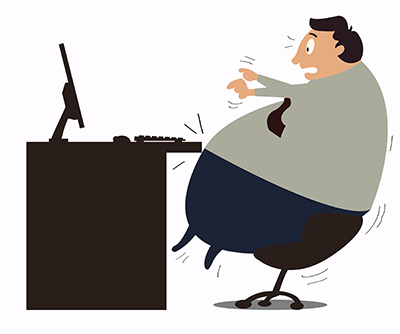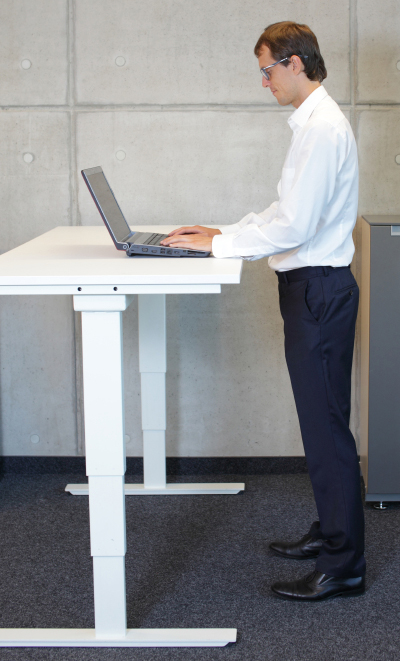Office Worker Health is Under Attack!
Institute’s Note: Our guest commentator, Nick Green, received his M.S. in organizational behavior management at the Florida Institute of Technology and is now a doctoral student in psychology at the University of Florida.
For most of you reading this commentary, you might be sitting. Quick! Stand up and stretch for the rest of it...
 Are you standing now? Good! Obesity researchers are discovering why too much sitting is bad for us. Regardless of where many of us work, our environment promotes little physical activity and mainly consists of swipes, clicks, key presses, and scrolls. You may have heard by now that “sitting is the new smoking.” The key issue is, regardless of whether you exercise, the more you sit, the more you are risk for a myriad of health issues (heart disease, obesity, diabetes). The physical risks associated with sitting can be heard here from one of the field's leading researchers, Dr. James Levine.
Are you standing now? Good! Obesity researchers are discovering why too much sitting is bad for us. Regardless of where many of us work, our environment promotes little physical activity and mainly consists of swipes, clicks, key presses, and scrolls. You may have heard by now that “sitting is the new smoking.” The key issue is, regardless of whether you exercise, the more you sit, the more you are risk for a myriad of health issues (heart disease, obesity, diabetes). The physical risks associated with sitting can be heard here from one of the field's leading researchers, Dr. James Levine.
 Although research on the harm of too much sitting is growing, we cannot forget how our behavior is affected by any doctor’s or health organization’s recommendation. Often, conclusions from these studies (or this commentary) give us certain ideas, or rules, to increase our physical activity in the workplace such as “sit less, move more,” "walk 10,000 steps per day" or “stand up during a conference call.” Each rule provides great direction, but is only half the battle. Rules can be powerful antecedents that start behavior down the right path, but may not keep it going. The behavior associated with any health benefit (getting out of our chairs more) must contact the right consequence (reinforcement) to develop and sustain health improvements.
Although research on the harm of too much sitting is growing, we cannot forget how our behavior is affected by any doctor’s or health organization’s recommendation. Often, conclusions from these studies (or this commentary) give us certain ideas, or rules, to increase our physical activity in the workplace such as “sit less, move more,” "walk 10,000 steps per day" or “stand up during a conference call.” Each rule provides great direction, but is only half the battle. Rules can be powerful antecedents that start behavior down the right path, but may not keep it going. The behavior associated with any health benefit (getting out of our chairs more) must contact the right consequence (reinforcement) to develop and sustain health improvements.
 Take the everyday task of delivering a message to a coworker. At any given time, there are various antecedents and consequences available for this task. First, we determine what options (antecedents) are available to deliver a message. I can either instant message a coworker (Option A) or walk downstairs to deliver the message in person (following a rule - Option B). Both options deliver the message, but Option B requires additional
Take the everyday task of delivering a message to a coworker. At any given time, there are various antecedents and consequences available for this task. First, we determine what options (antecedents) are available to deliver a message. I can either instant message a coworker (Option A) or walk downstairs to deliver the message in person (following a rule - Option B). Both options deliver the message, but Option B requires additional  physical activity. Option B may require additional reinforcement for it to occur more often and/or in place of Option A. That is, simply delivering the message on foot may not be a powerful enough consequence by itself to maintain this new type of physical activity. Perhaps Option B allows you to run into old colleagues in the hallway or learn about a company party you might have missed otherwise. These consequences may make it more likely that you deliver messages in person again and again.
physical activity. Option B may require additional reinforcement for it to occur more often and/or in place of Option A. That is, simply delivering the message on foot may not be a powerful enough consequence by itself to maintain this new type of physical activity. Perhaps Option B allows you to run into old colleagues in the hallway or learn about a company party you might have missed otherwise. These consequences may make it more likely that you deliver messages in person again and again.
As physical health recommendations are updated, it is imperative to consider how antecedents (e.g., rules) and consequences (reinforcement) play a role to increase physical activity at work. To begin chipping away at any poor health statistic (e.g., 2 out of 3 Americans are overweight or obese; Ogden, Carroll, Kit, & Flegal, 2014), individuals and organizations need to create an environment that encourages (has antecedents in place) physical activity and supports (reinforces) healthy behavior. The future is bright, because the science of human behavior gives us the tools we need to re-engineer our environment to develop a healthier work place for us all.
Reference:
Ogden, C.L., Carroll, M.D., Kit, B.K., & Flegal, K.M., (2014) Prevalence of Childhood and Adult Obesity in the United States, 2011-2012. Journal of the American Medical Association 311(8), 806-814.



